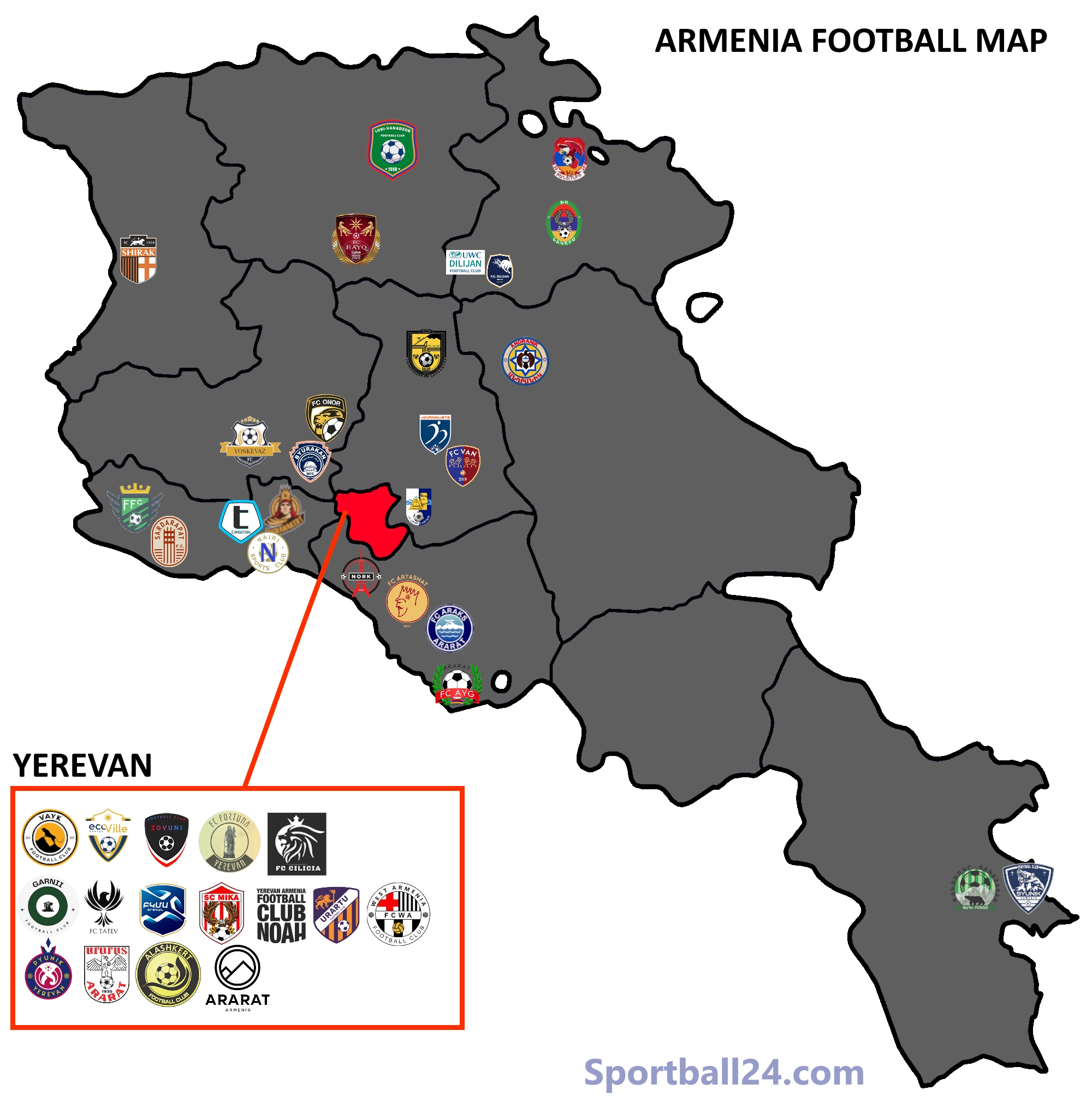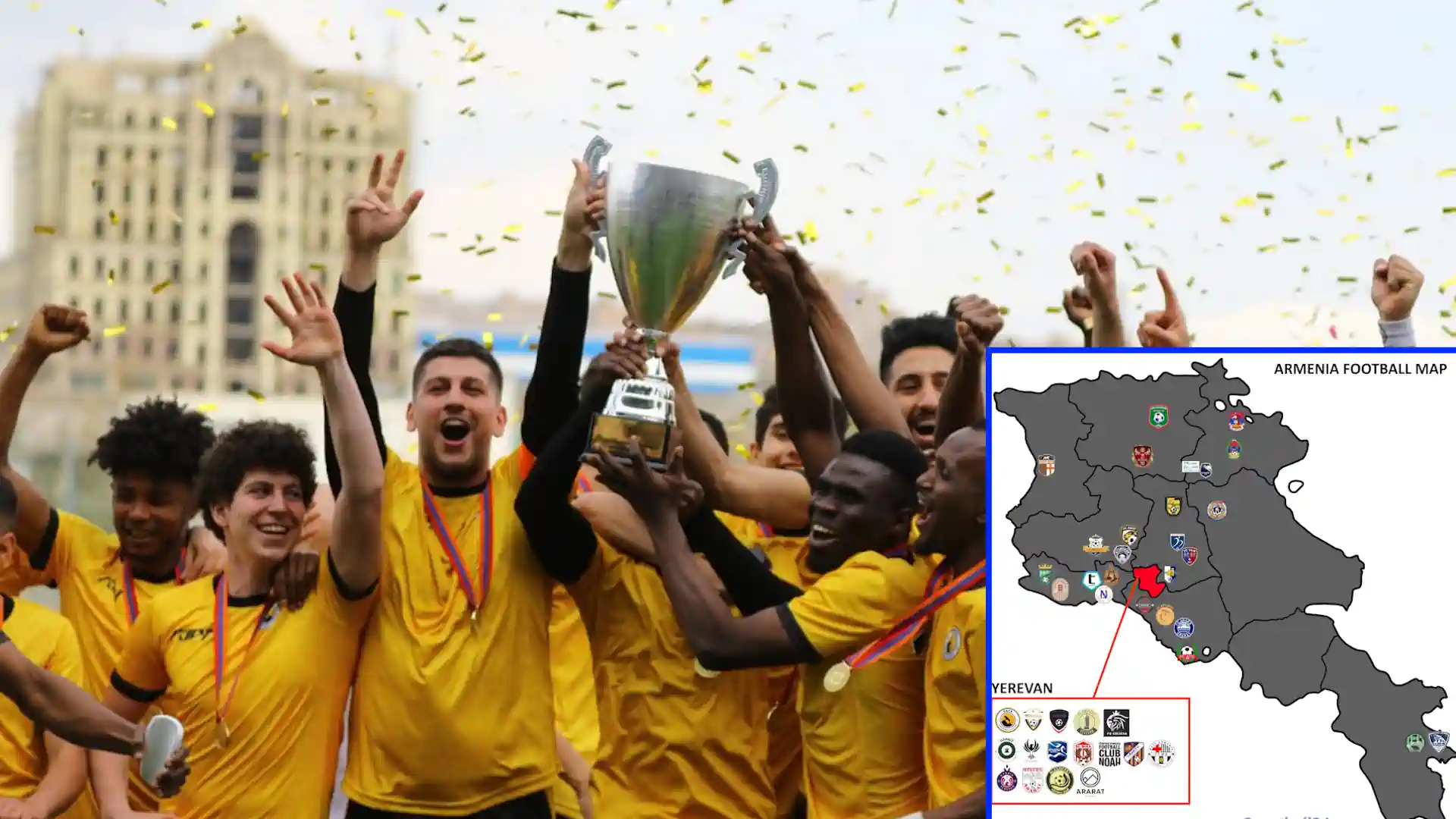Armenian football has long been a sore point, marked by decades of a lamentably inadequate football infrastructure, including stadiums, clubs, and academies. However, signs indicate that this state of affairs may be changing.
Following the initial promising results of the national team in the early 2010s, local sports enthusiasts have begun to witness encouraging developments in club football as well. From competitive matches against European counterparts to the qualification of teams like ‘Alashkert’ and ‘Pyunik’ for the group stage of the ‘Conference League’, there's been a palpable shift.
As of recent times, the once dwindling ‘Premier League’ of the country, which boasted just six professional clubs (with an additional three in the ‘First League’) during the 2017-2018 season, has seen notable expansion. Now, it comprises ten teams and encompasses four leagues, two of which are amateur. Here's an overview:
- Level 1: ID Armenian Premier League (10 teams)
- Level 2: First League (15 teams: 8 reserve teams and 7 professional teams).
- Level 3: Amateur A League (2 groups of 6 amateur teams each)
- Level 4: Amateur B League (2 groups, one with 4 amateur clubs, the other with 5).
These developments signal a promising trajectory for Armenian football, suggesting a potential revitalization of the sport within the country.

It turns out that today we have 16 professional clubs (excluding BCMA, which I will not mention further) and 21 amateur teams. Additionally, there are still around a dozen teams that do not participate in tournaments under the auspices of FFA. This growth is evident.
Let's revisit how football is organized in the Third Republic. It's worth noting that all teams rely solely on private funds, a rarity in post-Soviet realities. We find ourselves in a situation where money, albeit limited, has made its way into Armenian football, at all levels. New teams are emerging, and the overall standard is on the rise. But what about the quality? Let's delve into that.
Firstly, the state of football infrastructure (stadiums, etc.) is deplorable. Yes, there has been progress in recent years with the emergence of football stadiums in Armavir, Vanadzor, Artashat, and Abovyan, with FFA discussing other projects. However, none of these cities has its own football team. The listed clubs are forced to play wherever they can, but not at home.

Not only do LFL clubs lack the funds to build their own stadiums (which would cost at least $10-20 million), but even clubs in the Armenian Premier League do not have them. While plans for stadium construction are discussed, no concrete projects have materialized. This indicates a lack of funding. The reconstruction of dilapidated Soviet-era football infrastructure is costly. The result? Teams like the nominal FC ‘Vaik’, which supposedly represents a city but has no real connection with it, neither on paper nor in practice.
It's logical to assume that such clubs, along with others in similar situations, hold little interest for the local population. Without local support, these teams lack a solid foundation. The owners of football clubs in Armenia, who can hardly be called philanthropists, need to realize that when there's a substantial fan base behind a team, the responsibility and level of engagement change. We need more stadiums.
Secondly, who comprises these teams? Where do the players come from? Ideally, LFL clubs should consist primarily of local players, supplemented by recruits from elsewhere. However, due to the absence of academies on the ground, teams have nowhere to draw from. For thirty years, no efforts have been made to nurture local talent. Consequently, teams resort to recruiting foreigners, who now constitute at least 50% of the squads of most LFL teams. In some clubs, such as FC Garni, there may be only one player with an Armenian surname in the starting lineup. This is concerning, especially at the LFL level.
I may be mistaken, but I haven't seen any serious signs of the existence of our own academy within Armenian football. It seems that when establishing a football club, a location is chosen, games are played in a third city, and there's no solid foundation, yet football is played.
If I were a resident of Chambarak, I would want to support the local team, provided that our local players are involved and that they play in Chambarak. However, since neither our players nor the team itself are present, except perhaps on Facebook, why should I invest my emotions in them?
In summary, football in our country is following an unprecedented and perplexing path. Traditionally, football clubs are deeply rooted local institutions. While the Soviet past hindered the development of football in a Western manner, what we're witnessing today is a colossus on clay feet. How sustainable is it? How long will it last? Injecting private funds into football is a positive step, but it must be regulated by the FFA. While indulgences may be granted in the era of rapid football development, they should not be permitted once stability is achieved. Otherwise, we risk ending up with a scenario where there are only a handful of teams in the league, in which nobody is truly interested. This would prompt questions from the government about why funds are being invested in infrastructure that's underutilized and from the owners about the purpose of their investments.
Now, let's set aside criticism and offer some constructive suggestions from a subjective perspective. Let's consider Gegharkunik marz, home to approximately 200,000 people, with only one team representing the entire region - FC ‘Andranik’. While the team is commendable, there are numerous questions. A person with serious ambitions and long-term plans would emulate the approach of the owner of FC ‘Sardarapat’, or perhaps go even further. What would I do?
Firstly, I would establish a brand, define its ethos, and set objectives. I advocate for the ‘broken windows theory’ – order begins with small details, such as the logo and branding. There are several avenues for further development, but I would prioritize establishing a team that represents the entire area. To achieve this, it's worth establishing mini-football academies throughout the region in cities like Gavar, Sevan, Vardenis, Martuni, and Chambarak. If successful, mini-academies could even be set up in rural areas. All under one unified brand. This would initiate a process whereby hundreds of local children across all age groups are involved.
Next, I would establish a main academy where the best talents from across the region are selected around the age of 12-13. With diligent effort, a functional system could be established within five or six years. How much would this cost? A friend of mine sponsors a small team of approximately 50 players for 150,000֏ per month. Let's assume that in our case, it would cost 300,000֏ per month for one mini-youth academy, with ten such academies. This amounts to 36mn֏ annually, which we round up to 40mn֏ or $103,000. This investment is modest compared to the average budget of a club in League One, which ranges from $150,000 to $250,000 annually. However, instead of funding foreign players, this investment would establish a robust project with an eye toward the future.
Over ten years of dedicated effort, an investment of approximately $2,000,000 would be made. This is less than the budget Pyunik spent in a single championship-winning season, estimated at $3,000,000. Within a decade, players would have been developed, a brand established within the marz, and rapport built with the local community and authorities, who would recognize the seriousness and dedication of the project. With such a foundation, success in the Premier League would be gratifying, even if it's just securing a mid-table position. Who knows what could follow? Perhaps the investment will be repaid by the players themselves, or the team will attract sponsors, making dreams a reality. Most importantly, it's about building something substantial, not just a fleeting pursuit. Only through such fundamental projects, approached with utmost responsibility, can football in our country truly develop, avoiding the pitfall of mere statistics on paper.




